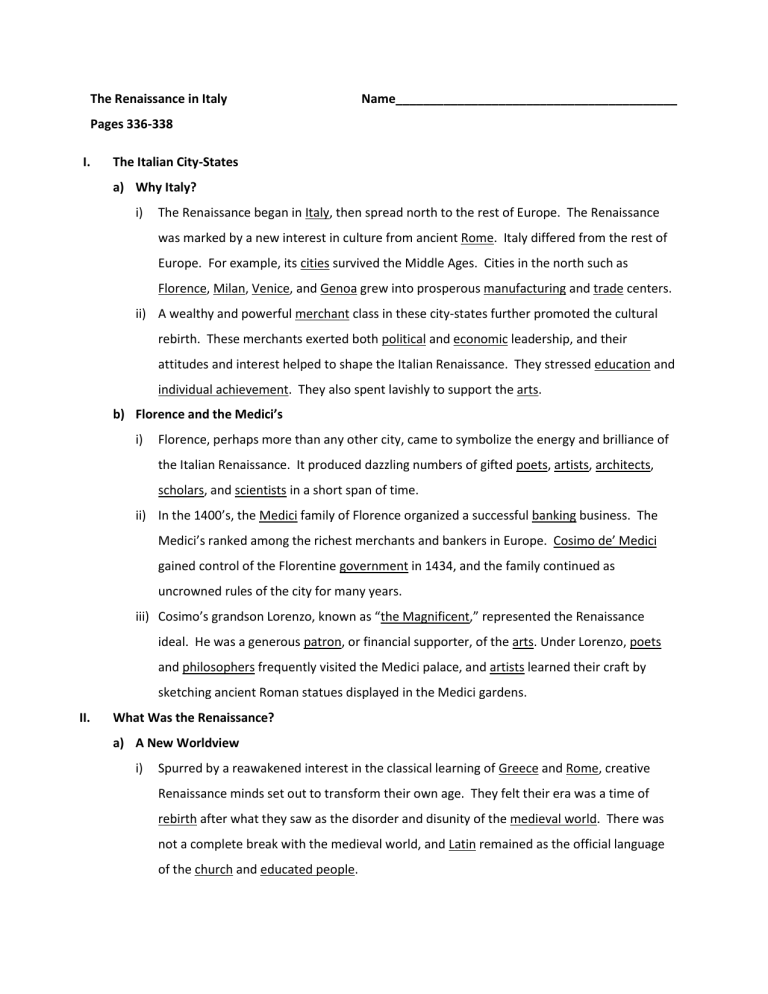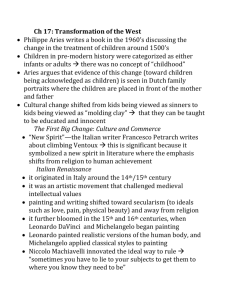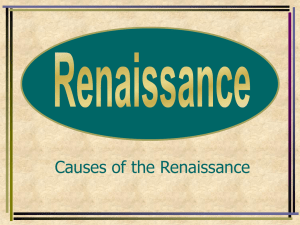The Renaissance in Italy

The Renaissance in Italy
Pages 336-338
Name_________________________________________
I.
The Italian City-States a) Why Italy? i) The Renaissance began in Italy, then spread north to the rest of Europe. The Renaissance was marked by a new interest in culture from ancient Rome. Italy differed from the rest of
Europe. For example, its cities survived the Middle Ages. Cities in the north such as
Florence, Milan, Venice, and Genoa grew into prosperous manufacturing and trade centers. ii) A wealthy and powerful merchant class in these city-states further promoted the cultural rebirth. These merchants exerted both political and economic leadership, and their attitudes and interest helped to shape the Italian Renaissance. They stressed education and individual achievement. They also spent lavishly to support the arts. b) Florence and the Medici’s i) Florence, perhaps more than any other city, came to symbolize the energy and brilliance of the Italian Renaissance. It produced dazzling numbers of gifted poets, artists, architects, scholars, and scientists in a short span of time. ii) In the 1400’s, the Medici family of Florence organized a successful banking business. The
Medici’s ranked among the richest merchants and bankers in Europe. Cosimo de’ Medici gained control of the Florentine government in 1434, and the family continued as uncrowned rules of the city for many years. iii) Cosimo’s grandson Lorenzo, known as “the Magnificent,” represented the Renaissance ideal. He was a generous patron, or financial supporter, of the arts. Under Lorenzo, poets and philosophers frequently visited the Medici palace, and artists learned their craft by sketching ancient Roman statues displayed in the Medici gardens.
II.
What Was the Renaissance? a) A New Worldview i) Spurred by a reawakened interest in the classical learning of Greece and Rome, creative
Renaissance minds set out to transform their own age. They felt their era was a time of rebirth after what they saw as the disorder and disunity of the medieval world. There was not a complete break with the medieval world, and Latin remained as the official language of the church and educated people.
ii) The Renaissance produced new attitudes toward culture and learning. Unlike medieval scholars, who were more likely to focus on life after death, Renaissance thinkers explored the richness and variety of human experience with a renewed emphasis on individual achievement. b) Spirit of Adventure i) The Renaissance supported a spirit of adventure and wide-ranging curiosity. The Italian navigator Christopher Columbus, who sailed to the Americas in 1492, represented that spirit. So did Nicolaus Copernicus, a Polish scientist who revolutionized the way people viewed the universe. c) Humanism i) At the heart of the Italian Renaissance was an intellectual movement known as humanism.
Based on the study of classical culture, humanism focused on worldly subjects rather than on the religious issues that had occupied medieval thinkers. Most humanist scholars were pious Christians. ii) Humanists believed that education should stimulate the individual’s creative powers. The returned to the humanities, the subjects taught in ancient Greek and Roman schools. The main areas of study were:
(1) Grammar
(2) Rhetoric
(3) Poetry
(4) History
Name_________________________________________
I.
The Italian City-States a) Why Italy? i) The Renaissance began in _______________, then spread north to the rest of Europe. The
Renaissance was marked by a new interest in culture from ancient _______________. Italy differed from the rest of Europe. For example, its _______________, survived the Middle
Ages. Cities in the north such as _______________, _______________, _______________, and _______________ grew into prosperous _______________ and _______________ centers. ii) A wealthy and powerful _______________ class in these city-states further promoted the cultural rebirth. These merchants exerted both _______________ and _______________ leadership, and their attitudes and interest helped to shape the Italian Renaissance. They stressed _______________ and _______________ _______________. They also spent lavishly to support the _______________. b) Florence and the Medici’s i) Florence, perhaps more than any other city, came to symbolize the energy and brilliance of the Italian Renaissance. It produced dazzling numbers of gifted _______________,
_______________, _______________, _______________, and _______________in a short span of time. ii) In the 1400’s, the _______________family of Florence organized a successful
_______________business. The Medici’s ranked among the richest merchants and bankers in Europe. _______________de’ _______________gained control of the Florentine
_______________in 1434, and the family continued as uncrowned rules of the city for many years. iii) Cosimo’s grandson Lorenzo, known as “___ _______________,” represented the
Renaissance ideal. He was a generous _______________, or financial supporter, of the
_______________. Under Lorenzo, _______________and _______________frequently visited the Medici palace, and _______________learned their craft by sketching ancient
Roman statues displayed in the Medici gardens.
The Renaissance in Italy
Pages 336-338
II.
What Was the Renaissance? a) A New Worldview i) Spurred by a reawakened interest in the classical learning of _______________and
_______________, creative Renaissance minds set out to transform their own age. They felt their era was a time of _______________after what they saw as the disorder and disunity of the ______________________________. There was not a complete break with the medieval world, and _______________remained as the official language of the
_______________and ______________________________. ii) The Renaissance produced new attitudes toward culture and learning. Unlike medieval scholars, who were more likely to focus on life after death, Renaissance thinkers explored the richness and variety of human experience with a renewed emphasis on
_______________ _______________. b) Spirit of Adventure i) The Renaissance supported a spirit of _______________and wide-ranging curiosity. The
Italian navigator ______________________________, who sailed to the Americas in
_______________, represented that spirit. So did ______________________________, a
Polish scientist who revolutionized the way people viewed the universe. c) Humanism i) At the heart of the Italian Renaissance was an intellectual movement known as
_______________. Based on the study of classical culture, humanism focused on
_______________subjects rather than on the _______________issues that had occupied medieval thinkers. Most humanist scholars were _______________ Christians. ii) Humanists believed that education should stimulate the individual’s _______________ powers. The returned to the _______________, the subjects taught in ancient
_______________ and _______________ schools. The main areas of study were:
(1) _______________
(2) _______________
(3) _______________
(4) _______________








